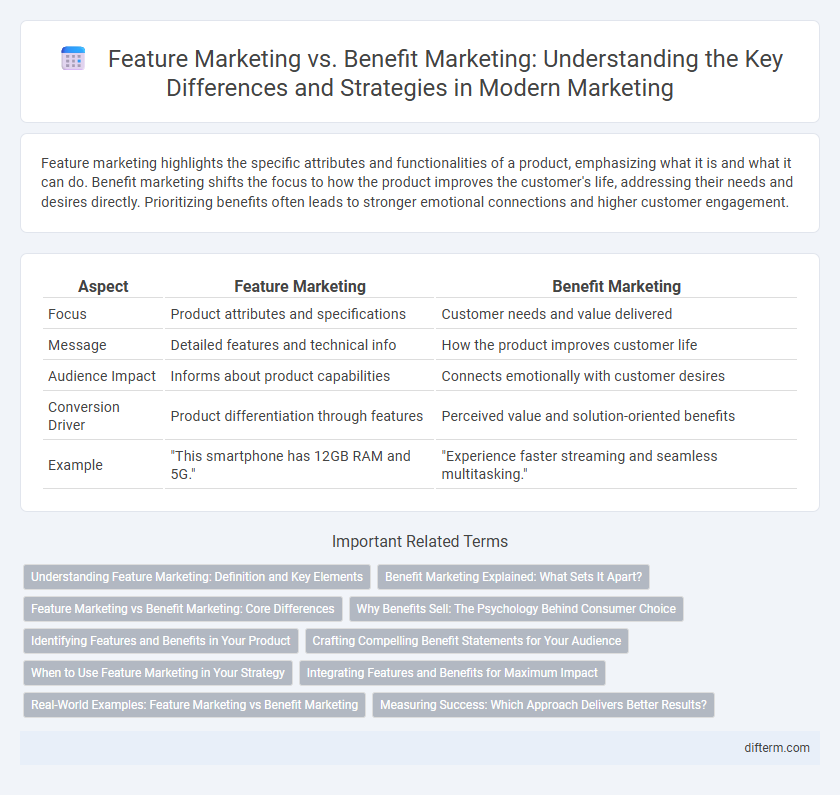Feature marketing highlights the specific attributes and functionalities of a product, emphasizing what it is and what it can do. Benefit marketing shifts the focus to how the product improves the customer's life, addressing their needs and desires directly. Prioritizing benefits often leads to stronger emotional connections and higher customer engagement.
Table of Comparison
| Aspect | Feature Marketing | Benefit Marketing |
|---|---|---|
| Focus | Product attributes and specifications | Customer needs and value delivered |
| Message | Detailed features and technical info | How the product improves customer life |
| Audience Impact | Informs about product capabilities | Connects emotionally with customer desires |
| Conversion Driver | Product differentiation through features | Perceived value and solution-oriented benefits |
| Example | "This smartphone has 12GB RAM and 5G." | "Experience faster streaming and seamless multitasking." |
Understanding Feature Marketing: Definition and Key Elements
Feature marketing emphasizes the characteristics and specifications of a product or service, aiming to inform consumers about its tangible attributes such as design, functionality, and technical details. Key elements include highlighting unique product features, demonstrating how these features differentiate the offering from competitors, and providing clear, factual information to support purchase decisions. This approach appeals to customers seeking detailed knowledge and rational justification for their buying choices.
Benefit Marketing Explained: What Sets It Apart?
Benefit marketing emphasizes the value and positive outcomes a product or service delivers to customers, highlighting how it improves their lives or solves specific problems. Unlike feature marketing, which focuses on the technical specifications or attributes of a product, benefit marketing connects directly with customer needs and emotions to drive purchasing decisions. This approach creates stronger engagement and loyalty by clearly demonstrating real-world advantages and customer-centric solutions.
Feature Marketing vs Benefit Marketing: Core Differences
Feature marketing emphasizes the specific attributes or functionalities of a product, highlighting technical details that appeal to the consumer's logical evaluation. Benefit marketing, on the other hand, focuses on how the product improves the customer's life, addressing emotional needs and practical outcomes. Understanding the core differences enables marketers to tailor messaging strategies that either inform through concrete features or persuade through relatable benefits.
Why Benefits Sell: The Psychology Behind Consumer Choice
Benefits sell because they directly address consumers' emotional and practical needs, creating a personal connection that features alone cannot achieve. Psychological research shows that customers prioritize outcomes and the value a product brings to their life over technical specifications. Focusing marketing on benefits leverages this insight, driving higher engagement and purchase motivation by aligning with the consumer's desire for problem-solving and satisfaction.
Identifying Features and Benefits in Your Product
Identifying features involves highlighting the specific attributes or characteristics of a product, such as size, color, or technical specifications. Benefit marketing emphasizes the advantages or value these features bring to the customer, like saving time, improving efficiency, or enhancing comfort. Effective marketing strategies clearly differentiate features from benefits to connect product capabilities with consumer needs and desires.
Crafting Compelling Benefit Statements for Your Audience
Crafting compelling benefit statements requires understanding your audience's core needs and emotions to highlight how your product improves their lives. Benefit marketing focuses on conveying tangible outcomes and personal value rather than just listing product features or specifications. Effective benefit statements create a strong emotional connection that drives consumer decision-making and brand loyalty.
When to Use Feature Marketing in Your Strategy
Feature marketing is most effective when targeting informed buyers who seek detailed product specifications and technical attributes. It works well in B2B markets or industries with complex products, where customers prioritize functionality and performance over emotional appeal. Using feature marketing helps highlight innovation, quality, and unique capabilities that differentiate your offering in competitive segments.
Integrating Features and Benefits for Maximum Impact
Integrating features and benefits in marketing leverages the technical attributes of a product alongside the emotional or practical value they provide to the customer. Highlighting features such as advanced AI algorithms or eco-friendly materials paired with benefits like time savings and sustainability appeal maximizes consumer engagement. This dual-focus strategy enhances message clarity, driving higher conversion rates and stronger brand loyalty.
Real-World Examples: Feature Marketing vs Benefit Marketing
Feature marketing emphasizes specific product attributes such as Apple highlighting the iPhone's advanced camera technology, while benefit marketing focuses on the user advantage, like Airbnb promoting the unique experience of living like a local. Tesla markets its electric vehicle's long-range battery as a feature, whereas its benefit marketing stresses saving money on fuel and reducing environmental impact. Effective marketing strategies blend feature and benefit messaging to resonate with both technical customers and emotionally-driven buyers.
Measuring Success: Which Approach Delivers Better Results?
Benefit marketing often delivers better measurable results by directly resonating with consumer needs and driving emotional engagement, which increases conversion rates and customer loyalty. Feature marketing can support success metrics by highlighting product specifications that appeal to a technical audience, but tends to underperform when emotional connection is crucial. Key performance indicators such as customer acquisition cost, lifetime value, and return on marketing investment typically show higher efficiency in campaigns centered around user benefits.
Feature Marketing vs Benefit Marketing Infographic

 difterm.com
difterm.com